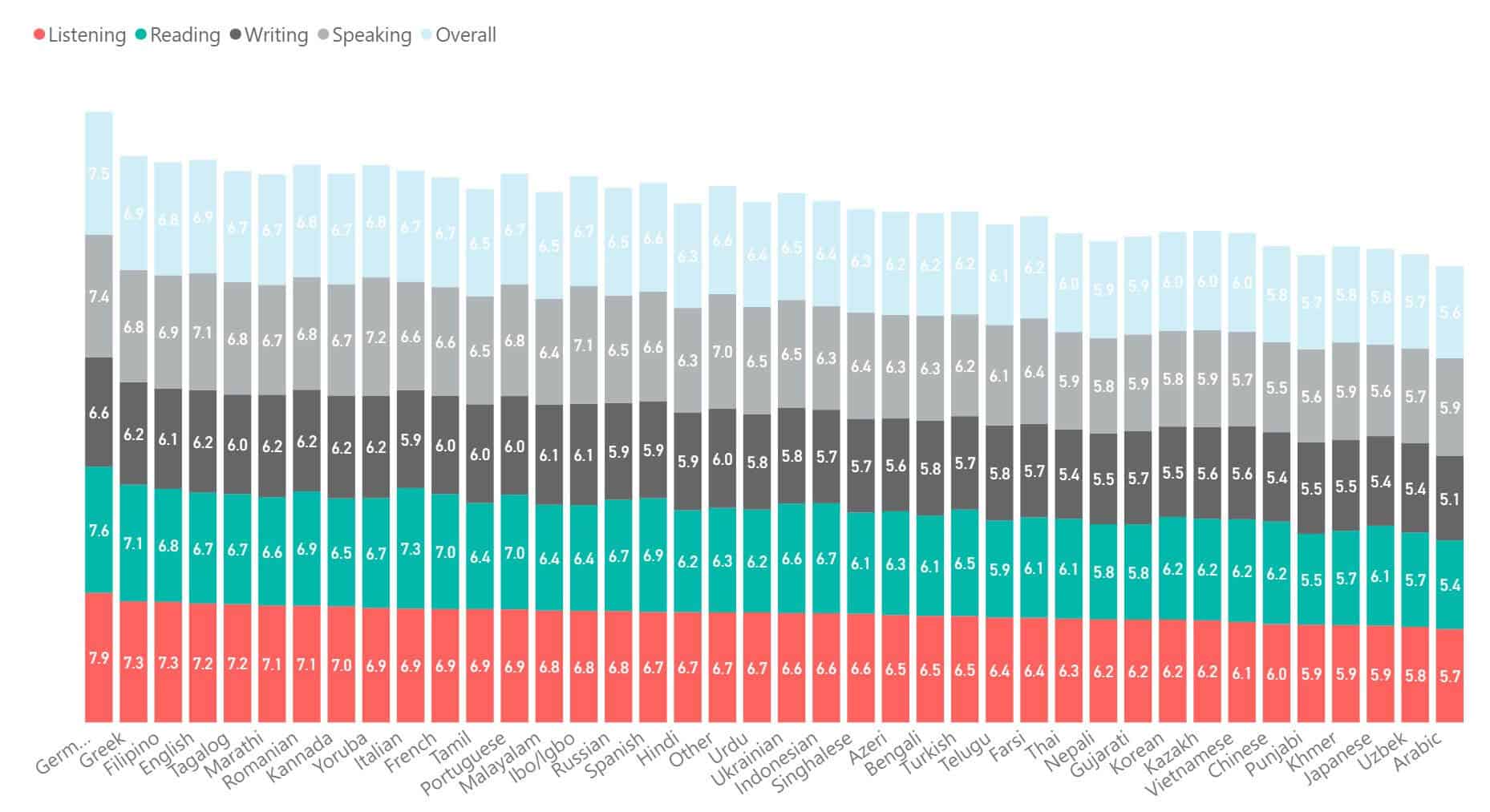If you want to migrate to most English-speaking countries, you’ll need to demonstrate a knowledge of the English language. There’s a standardized test for this, called the International English Language Testing System (IELTS).
Not only is the IELTS exam needed for immigration and work, it’s also required for many college programs. IELTS practice tests are a great way to prepare for the exam.
Just as you’d need to take the ACT for undergraduate admissions, or the GMAT for business school, most colleges and universities require you to take the IELTS.
Summary: Try an IELTS practice test below to see how much you already know.
IELTS Practice Tests
Before we talk about the IELTS exam, let’s talk about how you can prepare for it. There are a few different ways. You can take a practice test, to see where you currently stand.
You can also use flashcards to work on your English vocabulary. You can even watch movies to learn English in a more natural way. Here are 10+ resources for preparing for the IELTS exam.
| Resource | Notes | Provider |
| IELTS Practice Listening Test | IELTS | |
| IELTS Practice Reading Test | IELTS | |
| IELTS Practice General Training Reading | IELTS | |
| IELTS Practice Academic Writing | IELTS | |
| IELTS Practice General Training Writing | IELTS | |
| IELTS Practice Speaking Test | IELTS |
Additional IELTS Resources
| Resource | Notes | Provider |
| Free TOEFL Practice Tests | Review free reading practice tests to help with the English language. | Test-Guide |
| IELTS Flashcards | Review 250+ flashcards. | Quizlet |
| IELTS Flashcards 2 | Review 590+ flashcards. | Quizlet |
IELTS Content Outline
There are two different versions of the IELTS exam: the Academic and General Training tests. The Academic IELTS exam is for people who want to study at a college or university. It’s also for degree-holders who want to register for professions that require an advanced degree.
The General Training IELTS exam is for people who want to immigrate to the United Kingdom, Australia, Canada, or New Zealand. It’s also for students who want to study in an English-language country below the degree level.
The IELTS exam is divided into four different sections. There’s a listening section, a reading section, a writing section, and a speaking section. The reading, writing, and speaking portions are all given at once. The speaking section can either be taken at the same time, or up to a week later depending on your testing center.
The reading and writing portions of the exam are different, depending whether you’re taking the Academic or General Training exam. They can be taken either on paper or on a computer. The listening and speaking portions are the same between both tests, and are taken with a live supervisor. The total time for the IELTS exam is 2 hours and 45 minutes.
IELTS Exam Administration
So, how do you sign up for the IELTS exam? The first step is to find your local test center. There are over 1,600 test centers throughout the world, located in 140 countries. Once you’ve chosen your test center, you’ll need to register.
This can be done online, or you can print off a paper application from the IELTS website. Have your passport or government ID handy, as this information will be required.
Registration will also require a fee. Depending on your country, the fee can vary. Payment methods also vary by country, but almost all countries allow for credit card or check payment.
Once you’ve registered and paid the fee, your test center will send you a form confirming the date and time of your exam. If the speaking portion of the exam is being held at a different time, you’ll also get confirmation of that. On the test day, make sure you bring the same ID you used to register for the exam. If you don’t have ID, you will not be permitted to take the test.
Even under the best of circumstances, you might need to cancel or reschedule your exam. The British Council allows cancellations or rescheduling up to five weeks before the exam date. If you cancel before that time, you’ll get a full refund, with the exception of a small administration fee.
There’s one exception to this rule. If you have a serious illness, you can cancel at any time for a full refund. However, you’ll need to provide a doctor’s note to certify your illness. The note must be an original, not a copy. Keep in mind that these are the rules for the British Council, which oversees most IELTS tests. If your test center is working with a different provider, their rules may be different.
IELTS Exam Requirements
There are no requirements to take the IELTS exam. Anyone can take the exam, as long as they provide payment and a government ID. However, there are accommodations available for people with certain disabilities. These include:
- Longer time periods for individuals with dyslexia or for breastfeeding mothers.
- Braille tests for individuals who are blind.
- Enlarged print tests for individuals with vision difficulties.
- Special listening CDs that allow you to pause.
- A lip-reading version of the listening test for hearing-impaired individuals.
If you need any of these services, contact your IELTS testing center as soon as possible. For modified versions of the test, you’ll need to give three months’ notice. If you simply need extra time, you’ll need to give at least six weeks’ notice.
IELTS Scores
IELTS exam scores are based on a combination of the four different test sections. Test takers are rated on a 40-point scale, and can earn up to 10 points from each section of the test. At that point, they are sorted into nine different “bands”. Here’s a quick look at how those bands work:
0: The test taker did not take the test. If you simply don’t show up for your exam, you will fall into this band.
1: “Non user”. Very limited English comprehension, only a few words. If you fall into this band, you won’t even be able to read this article.
2: “Intermittent user”. You might understand some everyday phrases, but only with great difficulty.
3: “Extremely limited user”. You can understand everyday phrases, but not anything else.
4: “Limited user”. You can understand everyday phrases, as well as some familiar situations. But you’re not able to understand complex sentences or deal with unfamiliar situations.
5: “Modest user”. You can handle basic communication in your field. You can also deal with everyday conversations, but you’re likely to make some mistakes.
6: “Competent user”. You can effectively speak English in most familiar situations. You can also handle unfamiliar situations, but you’re likely to make some mistakes.
7: “Good user”. You can understand complex and detailed sentences. You might occasionally make mistakes, though.
8: “Very good user”. You can speak English almost as well as a native speaker. Any mistakes are unimportant and easy to clear up.
9: “Expert user”. You have complete command of the English language. You can understand and communicate effectively under any circumstances.
If you take the computer-based version of the test, you will receive your results in 5 to 7 days. For the paper-based version, you will receive your results in 13 days. You can either pick up your results from the testing center, or they will be mailed to you.
IELTS Mean Scores by First Language (Academic)
IELTS FAQs
Who owns and operates the IELTS exam?
IELTS is owned by the British Council, Cambridge Assessment English, and IDP: IELTS Australia. Teams from all three of these organizations write the questions for the test.
They do this in conjunction with test writers in Canada, New Zealand, the US, and other English-speaking countries. This ensures that the tests reflect current, real-world use of the English language.
Why are there two versions of the IELTS exam?
The reason there are two versions of the test is that English usage can be different depending on your circumstances.
For people who are coming to work or to immigrate, everyday language is more important. As a matter of fact, passing the General Training exam is mandatory for migration to the UK, Canada, Australia, and New Zealand.
For academic purposes, you’re going to need to understand more advanced terms and more complex sentences. The Academic version of the test is designed to ensure that you’re ready to begin study, or to receive a professional certificate.
What can I bring with me on test day?
We’ve already mentioned that you’ll need to bring the passport or government-issued ID that you used to register for the test. Other than that, only pens, pencils, and erasers are allowed into the test room.
If you have a phone, pager, or other electronic device, the test supervisor will provide a place for you to store those belongings while you’re taking the test.

